E-Learning in Higher Education: Advantages, Disadvantages, and Impact
VerifiedAdded on 2022/12/28
|7
|2085
|2
Report
AI Summary
This report provides a comprehensive analysis of e-learning in higher education, exploring its advantages and disadvantages in the context of the evolving educational landscape. It begins with an introduction to e-learning, emphasizing its shift towards digital sources and the impact of the COVID-19 pandemic on the Indian education sector. The main body delves into the various benefits of e-learning, such as efficiency, affordability, reduced absenteeism, and encouragement of shy students, while also addressing its challenges, including its unsuitability for all learning styles, technological issues, lack of social interaction, and potential for focus deficits. The report highlights the Indian government's initiatives to promote e-learning through investments in research and development, human resource development, and technological advancements. The conclusion emphasizes the growth of e-learning and its significance for the future of education, particularly in India, and the importance of addressing the challenges to maximize its potential. The report references various books and journals to support its analysis and findings. This document is a valuable resource for students seeking to understand the complexities of e-learning in higher education.
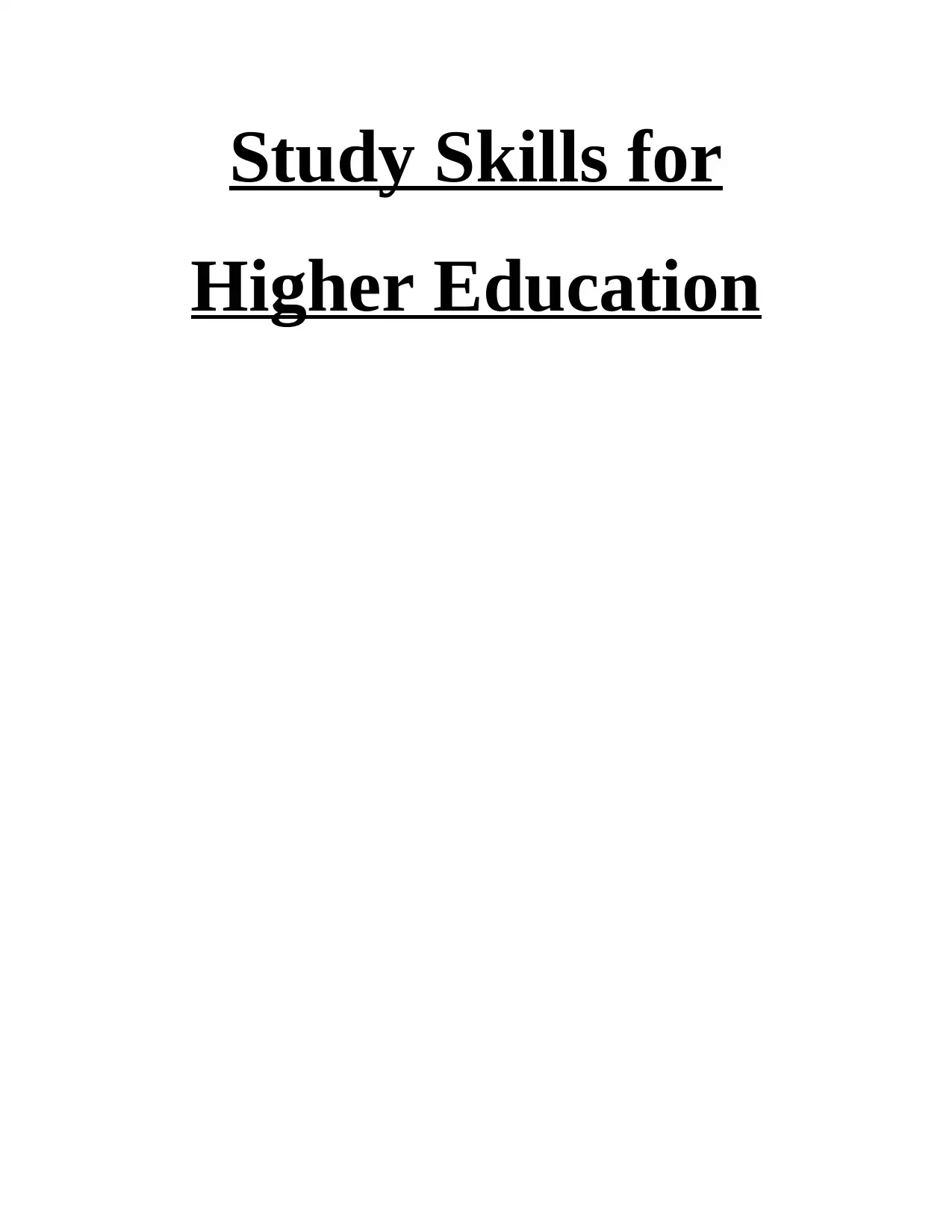
Study Skills for
Higher Education
Higher Education
Paraphrase This Document
Need a fresh take? Get an instant paraphrase of this document with our AI Paraphraser
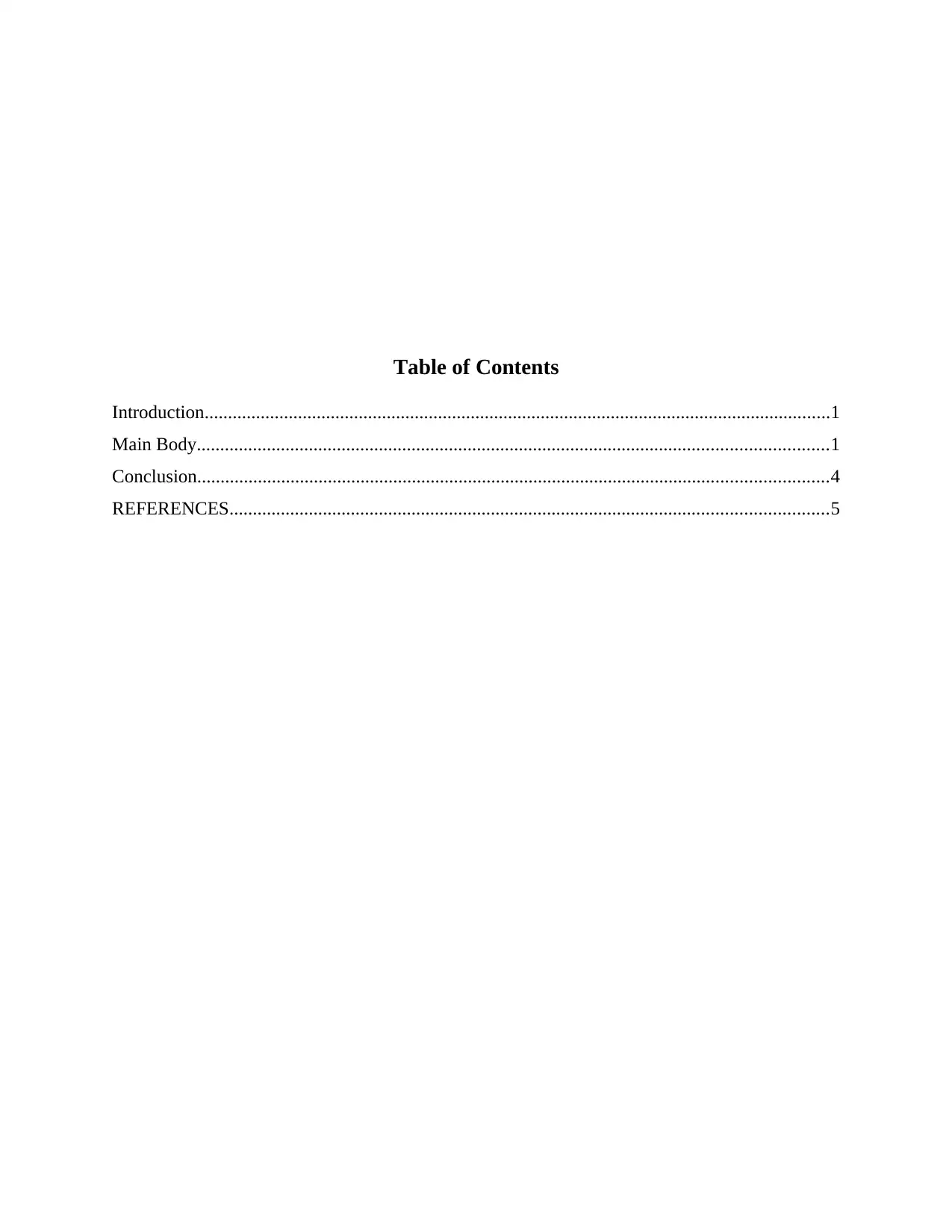
Table of Contents
Introduction......................................................................................................................................1
Main Body.......................................................................................................................................1
Conclusion.......................................................................................................................................4
REFERENCES................................................................................................................................5
Introduction......................................................................................................................................1
Main Body.......................................................................................................................................1
Conclusion.......................................................................................................................................4
REFERENCES................................................................................................................................5
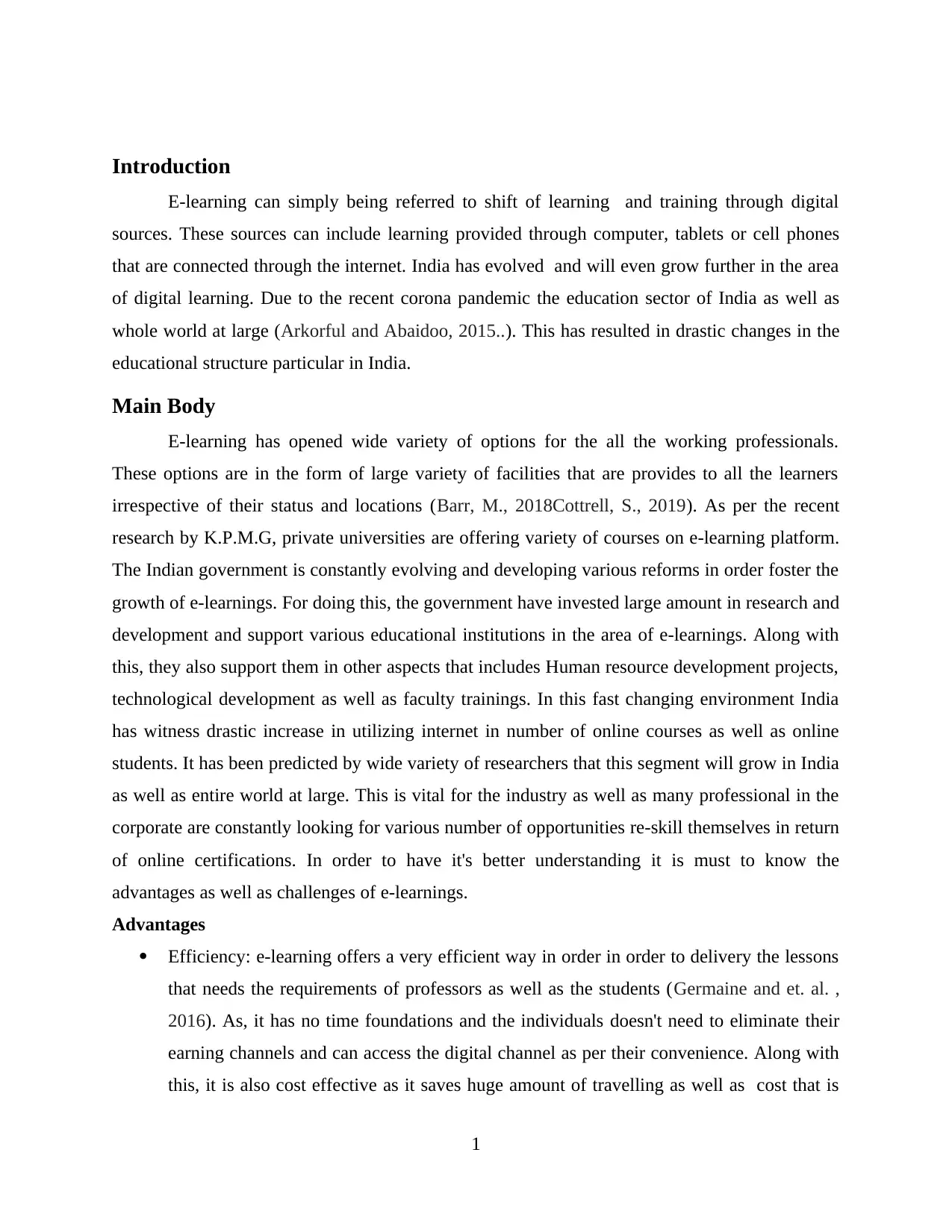
Introduction
E-learning can simply being referred to shift of learning and training through digital
sources. These sources can include learning provided through computer, tablets or cell phones
that are connected through the internet. India has evolved and will even grow further in the area
of digital learning. Due to the recent corona pandemic the education sector of India as well as
whole world at large (Arkorful and Abaidoo, 2015..). This has resulted in drastic changes in the
educational structure particular in India.
Main Body
E-learning has opened wide variety of options for the all the working professionals.
These options are in the form of large variety of facilities that are provides to all the learners
irrespective of their status and locations (Barr, M., 2018Cottrell, S., 2019). As per the recent
research by K.P.M.G, private universities are offering variety of courses on e-learning platform.
The Indian government is constantly evolving and developing various reforms in order foster the
growth of e-learnings. For doing this, the government have invested large amount in research and
development and support various educational institutions in the area of e-learnings. Along with
this, they also support them in other aspects that includes Human resource development projects,
technological development as well as faculty trainings. In this fast changing environment India
has witness drastic increase in utilizing internet in number of online courses as well as online
students. It has been predicted by wide variety of researchers that this segment will grow in India
as well as entire world at large. This is vital for the industry as well as many professional in the
corporate are constantly looking for various number of opportunities re-skill themselves in return
of online certifications. In order to have it's better understanding it is must to know the
advantages as well as challenges of e-learnings.
Advantages
Efficiency: e-learning offers a very efficient way in order in order to delivery the lessons
that needs the requirements of professors as well as the students (Germaine and et. al. ,
2016). As, it has no time foundations and the individuals doesn't need to eliminate their
earning channels and can access the digital channel as per their convenience. Along with
this, it is also cost effective as it saves huge amount of travelling as well as cost that is
1
E-learning can simply being referred to shift of learning and training through digital
sources. These sources can include learning provided through computer, tablets or cell phones
that are connected through the internet. India has evolved and will even grow further in the area
of digital learning. Due to the recent corona pandemic the education sector of India as well as
whole world at large (Arkorful and Abaidoo, 2015..). This has resulted in drastic changes in the
educational structure particular in India.
Main Body
E-learning has opened wide variety of options for the all the working professionals.
These options are in the form of large variety of facilities that are provides to all the learners
irrespective of their status and locations (Barr, M., 2018Cottrell, S., 2019). As per the recent
research by K.P.M.G, private universities are offering variety of courses on e-learning platform.
The Indian government is constantly evolving and developing various reforms in order foster the
growth of e-learnings. For doing this, the government have invested large amount in research and
development and support various educational institutions in the area of e-learnings. Along with
this, they also support them in other aspects that includes Human resource development projects,
technological development as well as faculty trainings. In this fast changing environment India
has witness drastic increase in utilizing internet in number of online courses as well as online
students. It has been predicted by wide variety of researchers that this segment will grow in India
as well as entire world at large. This is vital for the industry as well as many professional in the
corporate are constantly looking for various number of opportunities re-skill themselves in return
of online certifications. In order to have it's better understanding it is must to know the
advantages as well as challenges of e-learnings.
Advantages
Efficiency: e-learning offers a very efficient way in order in order to delivery the lessons
that needs the requirements of professors as well as the students (Germaine and et. al. ,
2016). As, it has no time foundations and the individuals doesn't need to eliminate their
earning channels and can access the digital channel as per their convenience. Along with
this, it is also cost effective as it saves huge amount of travelling as well as cost that is
1
⊘ This is a preview!⊘
Do you want full access?
Subscribe today to unlock all pages.

Trusted by 1+ million students worldwide
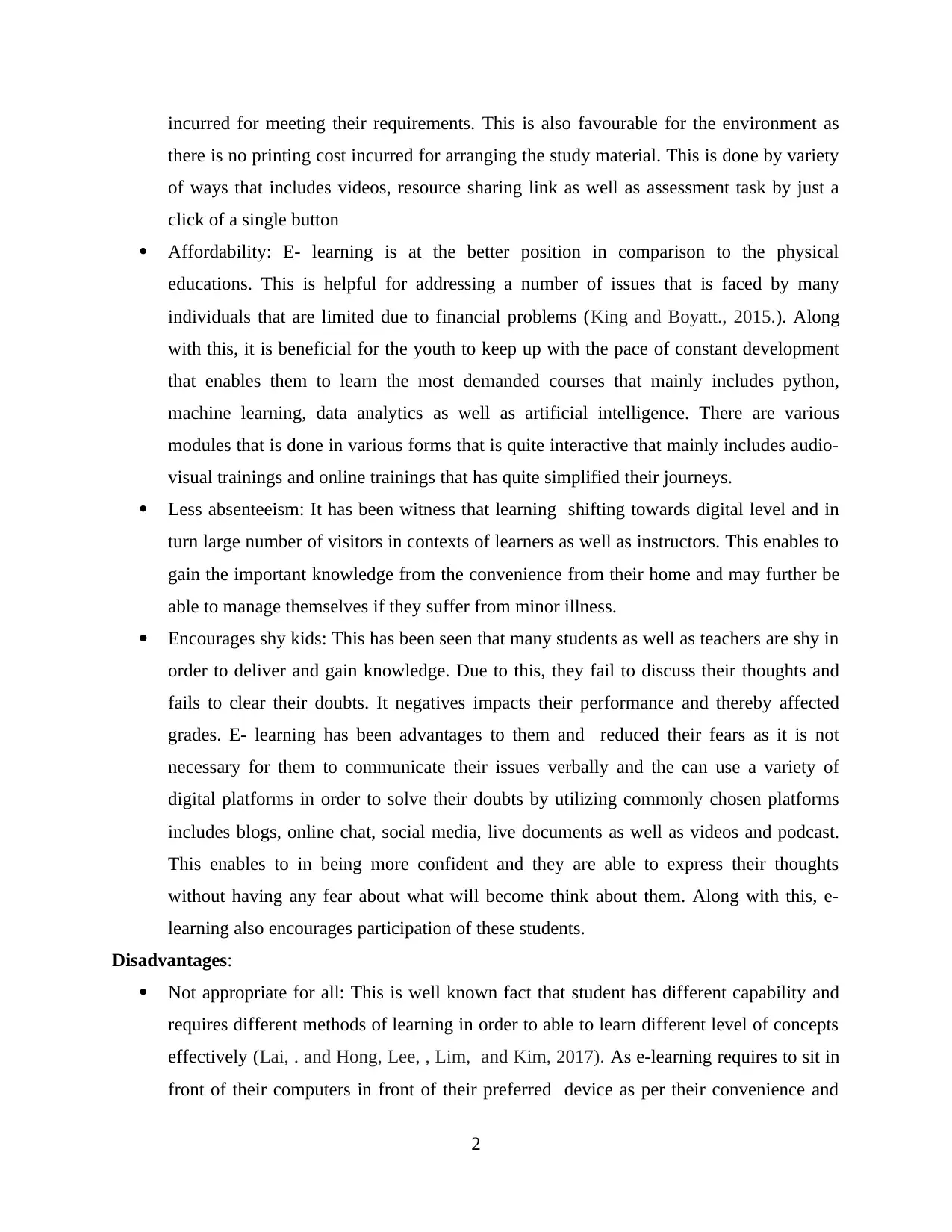
incurred for meeting their requirements. This is also favourable for the environment as
there is no printing cost incurred for arranging the study material. This is done by variety
of ways that includes videos, resource sharing link as well as assessment task by just a
click of a single button
Affordability: E- learning is at the better position in comparison to the physical
educations. This is helpful for addressing a number of issues that is faced by many
individuals that are limited due to financial problems (King and Boyatt., 2015.). Along
with this, it is beneficial for the youth to keep up with the pace of constant development
that enables them to learn the most demanded courses that mainly includes python,
machine learning, data analytics as well as artificial intelligence. There are various
modules that is done in various forms that is quite interactive that mainly includes audio-
visual trainings and online trainings that has quite simplified their journeys.
Less absenteeism: It has been witness that learning shifting towards digital level and in
turn large number of visitors in contexts of learners as well as instructors. This enables to
gain the important knowledge from the convenience from their home and may further be
able to manage themselves if they suffer from minor illness.
Encourages shy kids: This has been seen that many students as well as teachers are shy in
order to deliver and gain knowledge. Due to this, they fail to discuss their thoughts and
fails to clear their doubts. It negatives impacts their performance and thereby affected
grades. E- learning has been advantages to them and reduced their fears as it is not
necessary for them to communicate their issues verbally and the can use a variety of
digital platforms in order to solve their doubts by utilizing commonly chosen platforms
includes blogs, online chat, social media, live documents as well as videos and podcast.
This enables to in being more confident and they are able to express their thoughts
without having any fear about what will become think about them. Along with this, e-
learning also encourages participation of these students.
Disadvantages:
Not appropriate for all: This is well known fact that student has different capability and
requires different methods of learning in order to able to learn different level of concepts
effectively (Lai, . and Hong, Lee, , Lim, and Kim, 2017). As e-learning requires to sit in
front of their computers in front of their preferred device as per their convenience and
2
there is no printing cost incurred for arranging the study material. This is done by variety
of ways that includes videos, resource sharing link as well as assessment task by just a
click of a single button
Affordability: E- learning is at the better position in comparison to the physical
educations. This is helpful for addressing a number of issues that is faced by many
individuals that are limited due to financial problems (King and Boyatt., 2015.). Along
with this, it is beneficial for the youth to keep up with the pace of constant development
that enables them to learn the most demanded courses that mainly includes python,
machine learning, data analytics as well as artificial intelligence. There are various
modules that is done in various forms that is quite interactive that mainly includes audio-
visual trainings and online trainings that has quite simplified their journeys.
Less absenteeism: It has been witness that learning shifting towards digital level and in
turn large number of visitors in contexts of learners as well as instructors. This enables to
gain the important knowledge from the convenience from their home and may further be
able to manage themselves if they suffer from minor illness.
Encourages shy kids: This has been seen that many students as well as teachers are shy in
order to deliver and gain knowledge. Due to this, they fail to discuss their thoughts and
fails to clear their doubts. It negatives impacts their performance and thereby affected
grades. E- learning has been advantages to them and reduced their fears as it is not
necessary for them to communicate their issues verbally and the can use a variety of
digital platforms in order to solve their doubts by utilizing commonly chosen platforms
includes blogs, online chat, social media, live documents as well as videos and podcast.
This enables to in being more confident and they are able to express their thoughts
without having any fear about what will become think about them. Along with this, e-
learning also encourages participation of these students.
Disadvantages:
Not appropriate for all: This is well known fact that student has different capability and
requires different methods of learning in order to able to learn different level of concepts
effectively (Lai, . and Hong, Lee, , Lim, and Kim, 2017). As e-learning requires to sit in
front of their computers in front of their preferred device as per their convenience and
2
Paraphrase This Document
Need a fresh take? Get an instant paraphrase of this document with our AI Paraphraser
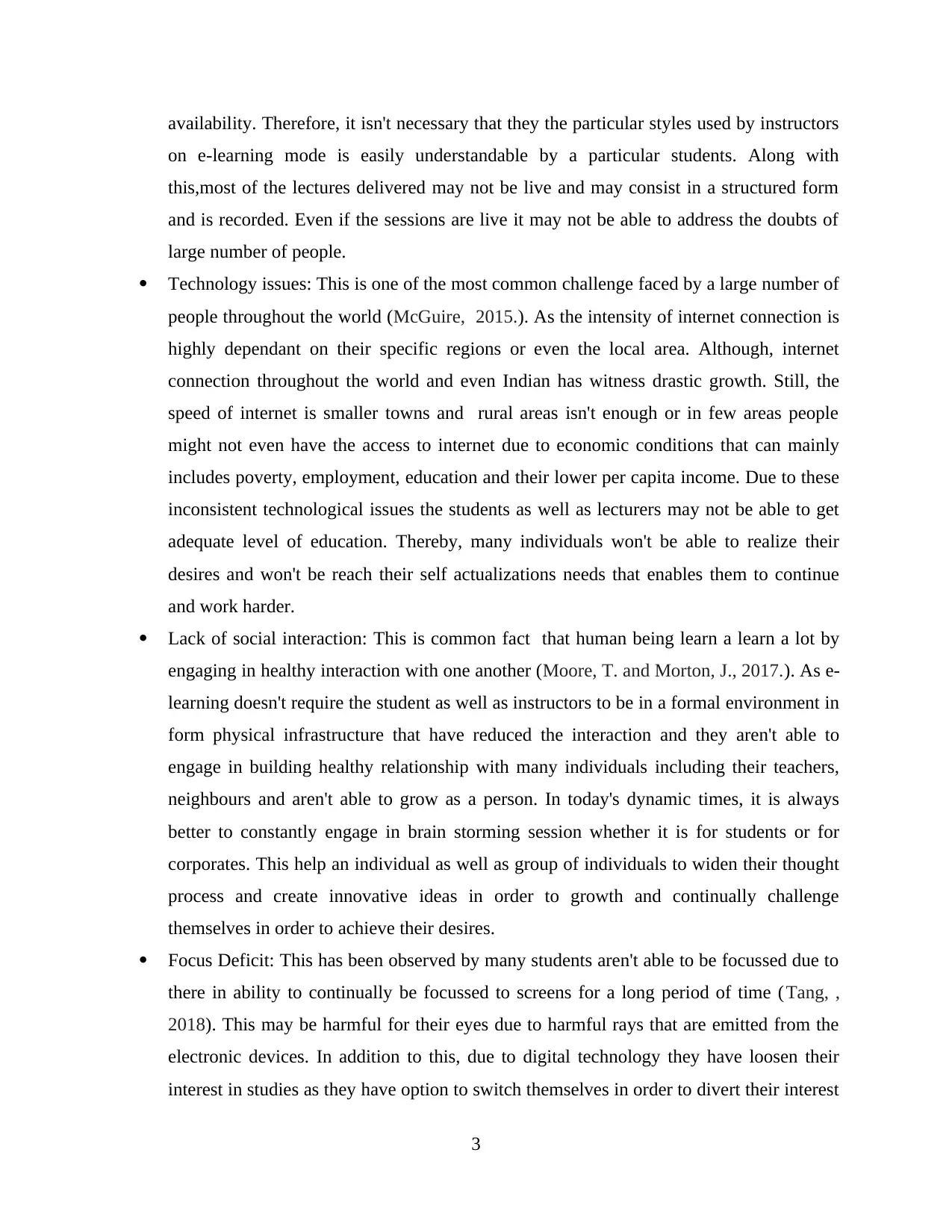
availability. Therefore, it isn't necessary that they the particular styles used by instructors
on e-learning mode is easily understandable by a particular students. Along with
this,most of the lectures delivered may not be live and may consist in a structured form
and is recorded. Even if the sessions are live it may not be able to address the doubts of
large number of people.
Technology issues: This is one of the most common challenge faced by a large number of
people throughout the world (McGuire, 2015.). As the intensity of internet connection is
highly dependant on their specific regions or even the local area. Although, internet
connection throughout the world and even Indian has witness drastic growth. Still, the
speed of internet is smaller towns and rural areas isn't enough or in few areas people
might not even have the access to internet due to economic conditions that can mainly
includes poverty, employment, education and their lower per capita income. Due to these
inconsistent technological issues the students as well as lecturers may not be able to get
adequate level of education. Thereby, many individuals won't be able to realize their
desires and won't be reach their self actualizations needs that enables them to continue
and work harder.
Lack of social interaction: This is common fact that human being learn a learn a lot by
engaging in healthy interaction with one another (Moore, T. and Morton, J., 2017.). As e-
learning doesn't require the student as well as instructors to be in a formal environment in
form physical infrastructure that have reduced the interaction and they aren't able to
engage in building healthy relationship with many individuals including their teachers,
neighbours and aren't able to grow as a person. In today's dynamic times, it is always
better to constantly engage in brain storming session whether it is for students or for
corporates. This help an individual as well as group of individuals to widen their thought
process and create innovative ideas in order to growth and continually challenge
themselves in order to achieve their desires.
Focus Deficit: This has been observed by many students aren't able to be focussed due to
there in ability to continually be focussed to screens for a long period of time (Tang, ,
2018). This may be harmful for their eyes due to harmful rays that are emitted from the
electronic devices. In addition to this, due to digital technology they have loosen their
interest in studies as they have option to switch themselves in order to divert their interest
3
on e-learning mode is easily understandable by a particular students. Along with
this,most of the lectures delivered may not be live and may consist in a structured form
and is recorded. Even if the sessions are live it may not be able to address the doubts of
large number of people.
Technology issues: This is one of the most common challenge faced by a large number of
people throughout the world (McGuire, 2015.). As the intensity of internet connection is
highly dependant on their specific regions or even the local area. Although, internet
connection throughout the world and even Indian has witness drastic growth. Still, the
speed of internet is smaller towns and rural areas isn't enough or in few areas people
might not even have the access to internet due to economic conditions that can mainly
includes poverty, employment, education and their lower per capita income. Due to these
inconsistent technological issues the students as well as lecturers may not be able to get
adequate level of education. Thereby, many individuals won't be able to realize their
desires and won't be reach their self actualizations needs that enables them to continue
and work harder.
Lack of social interaction: This is common fact that human being learn a learn a lot by
engaging in healthy interaction with one another (Moore, T. and Morton, J., 2017.). As e-
learning doesn't require the student as well as instructors to be in a formal environment in
form physical infrastructure that have reduced the interaction and they aren't able to
engage in building healthy relationship with many individuals including their teachers,
neighbours and aren't able to grow as a person. In today's dynamic times, it is always
better to constantly engage in brain storming session whether it is for students or for
corporates. This help an individual as well as group of individuals to widen their thought
process and create innovative ideas in order to growth and continually challenge
themselves in order to achieve their desires.
Focus Deficit: This has been observed by many students aren't able to be focussed due to
there in ability to continually be focussed to screens for a long period of time (Tang, ,
2018). This may be harmful for their eyes due to harmful rays that are emitted from the
electronic devices. In addition to this, due to digital technology they have loosen their
interest in studies as they have option to switch themselves in order to divert their interest
3
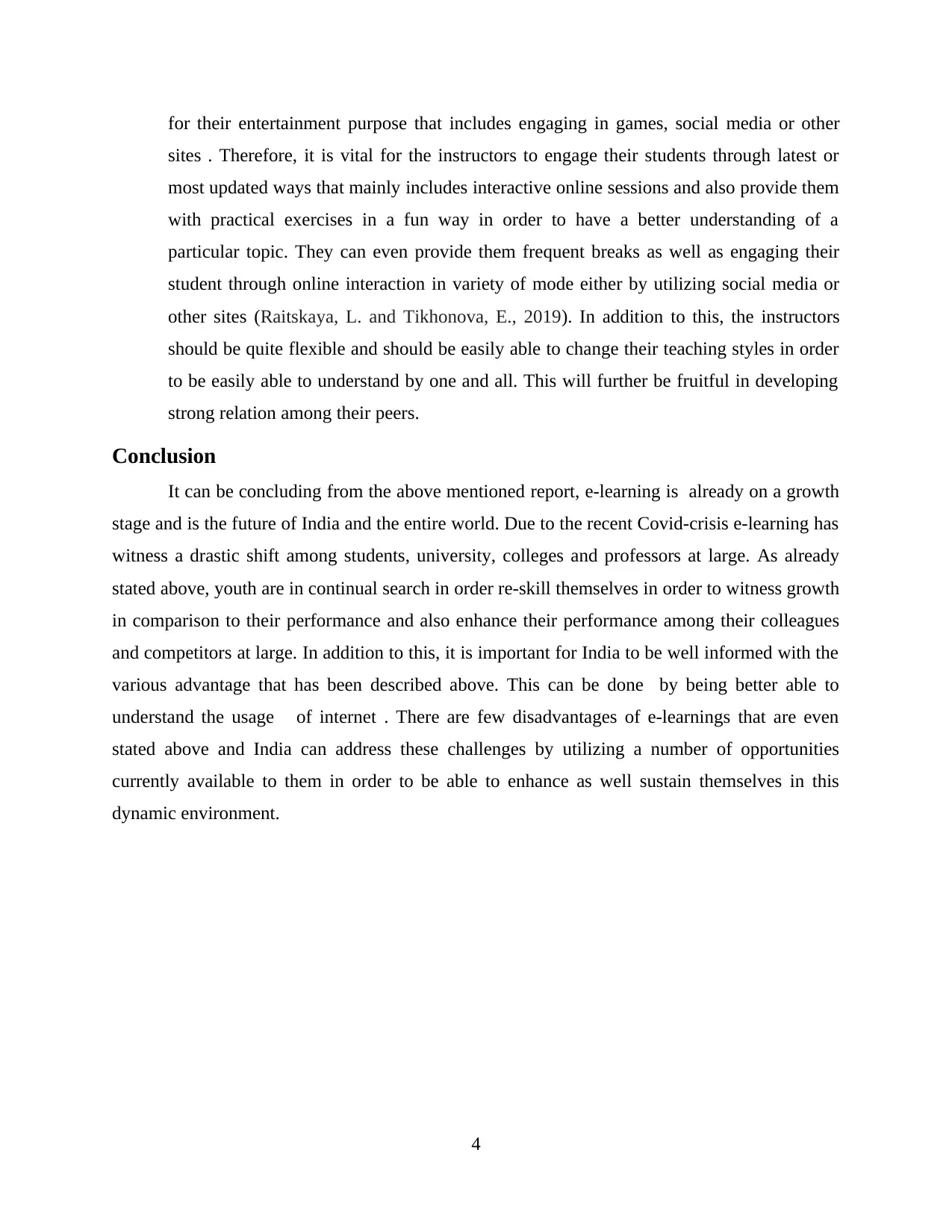
for their entertainment purpose that includes engaging in games, social media or other
sites . Therefore, it is vital for the instructors to engage their students through latest or
most updated ways that mainly includes interactive online sessions and also provide them
with practical exercises in a fun way in order to have a better understanding of a
particular topic. They can even provide them frequent breaks as well as engaging their
student through online interaction in variety of mode either by utilizing social media or
other sites (Raitskaya, L. and Tikhonova, E., 2019). In addition to this, the instructors
should be quite flexible and should be easily able to change their teaching styles in order
to be easily able to understand by one and all. This will further be fruitful in developing
strong relation among their peers.
Conclusion
It can be concluding from the above mentioned report, e-learning is already on a growth
stage and is the future of India and the entire world. Due to the recent Covid-crisis e-learning has
witness a drastic shift among students, university, colleges and professors at large. As already
stated above, youth are in continual search in order re-skill themselves in order to witness growth
in comparison to their performance and also enhance their performance among their colleagues
and competitors at large. In addition to this, it is important for India to be well informed with the
various advantage that has been described above. This can be done by being better able to
understand the usage of internet . There are few disadvantages of e-learnings that are even
stated above and India can address these challenges by utilizing a number of opportunities
currently available to them in order to be able to enhance as well sustain themselves in this
dynamic environment.
4
sites . Therefore, it is vital for the instructors to engage their students through latest or
most updated ways that mainly includes interactive online sessions and also provide them
with practical exercises in a fun way in order to have a better understanding of a
particular topic. They can even provide them frequent breaks as well as engaging their
student through online interaction in variety of mode either by utilizing social media or
other sites (Raitskaya, L. and Tikhonova, E., 2019). In addition to this, the instructors
should be quite flexible and should be easily able to change their teaching styles in order
to be easily able to understand by one and all. This will further be fruitful in developing
strong relation among their peers.
Conclusion
It can be concluding from the above mentioned report, e-learning is already on a growth
stage and is the future of India and the entire world. Due to the recent Covid-crisis e-learning has
witness a drastic shift among students, university, colleges and professors at large. As already
stated above, youth are in continual search in order re-skill themselves in order to witness growth
in comparison to their performance and also enhance their performance among their colleagues
and competitors at large. In addition to this, it is important for India to be well informed with the
various advantage that has been described above. This can be done by being better able to
understand the usage of internet . There are few disadvantages of e-learnings that are even
stated above and India can address these challenges by utilizing a number of opportunities
currently available to them in order to be able to enhance as well sustain themselves in this
dynamic environment.
4
⊘ This is a preview!⊘
Do you want full access?
Subscribe today to unlock all pages.

Trusted by 1+ million students worldwide
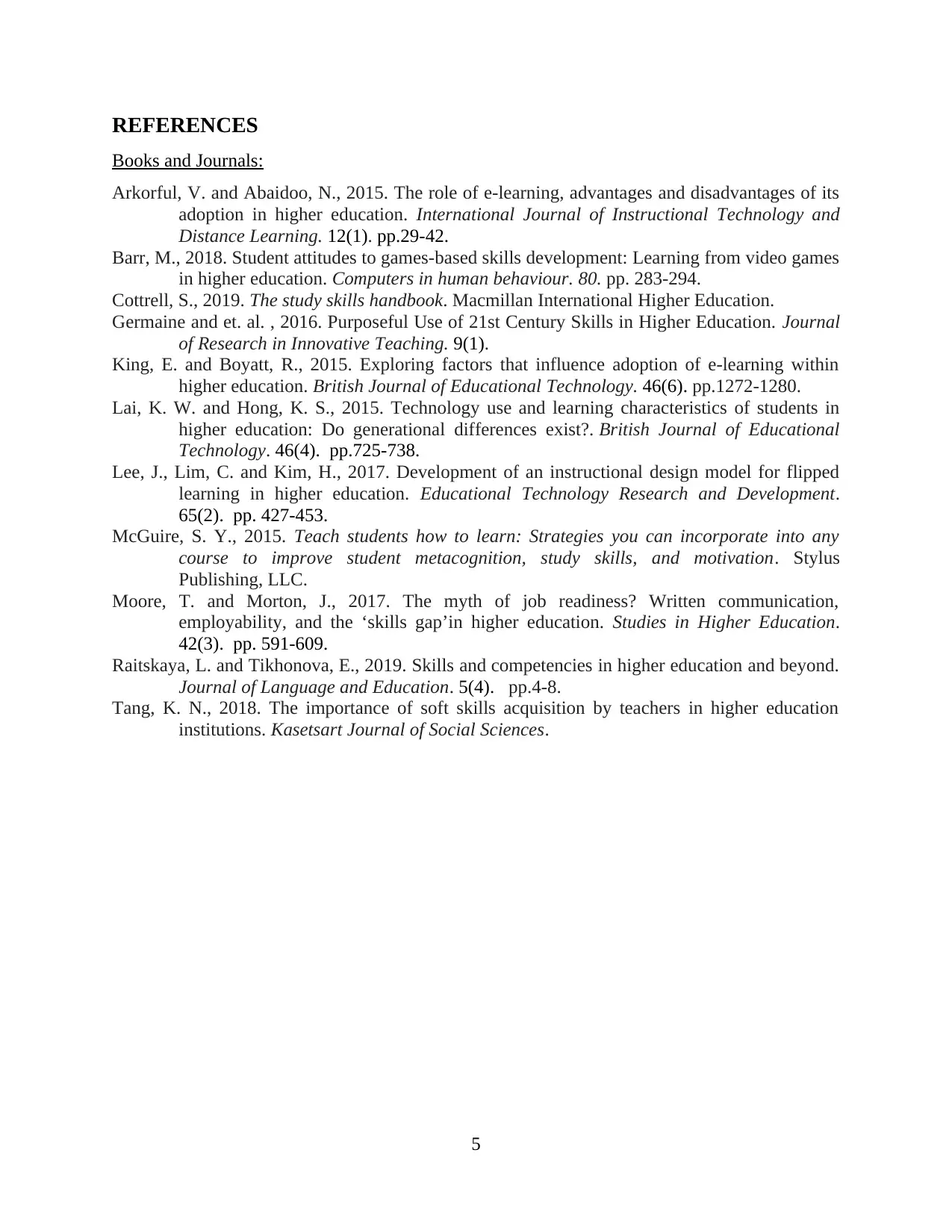
REFERENCES
Books and Journals:
Arkorful, V. and Abaidoo, N., 2015. The role of e-learning, advantages and disadvantages of its
adoption in higher education. International Journal of Instructional Technology and
Distance Learning. 12(1). pp.29-42.
Barr, M., 2018. Student attitudes to games-based skills development: Learning from video games
in higher education. Computers in human behaviour. 80. pp. 283-294.
Cottrell, S., 2019. The study skills handbook. Macmillan International Higher Education.
Germaine and et. al. , 2016. Purposeful Use of 21st Century Skills in Higher Education. Journal
of Research in Innovative Teaching. 9(1).
King, E. and Boyatt, R., 2015. Exploring factors that influence adoption of e‐learning within
higher education. British Journal of Educational Technology. 46(6). pp.1272-1280.
Lai, K. W. and Hong, K. S., 2015. Technology use and learning characteristics of students in
higher education: Do generational differences exist?. British Journal of Educational
Technology. 46(4). pp.725-738.
Lee, J., Lim, C. and Kim, H., 2017. Development of an instructional design model for flipped
learning in higher education. Educational Technology Research and Development.
65(2). pp. 427-453.
McGuire, S. Y., 2015. Teach students how to learn: Strategies you can incorporate into any
course to improve student metacognition, study skills, and motivation. Stylus
Publishing, LLC.
Moore, T. and Morton, J., 2017. The myth of job readiness? Written communication,
employability, and the ‘skills gap’in higher education. Studies in Higher Education.
42(3). pp. 591-609.
Raitskaya, L. and Tikhonova, E., 2019. Skills and competencies in higher education and beyond.
Journal of Language and Education. 5(4). pp.4-8.
Tang, K. N., 2018. The importance of soft skills acquisition by teachers in higher education
institutions. Kasetsart Journal of Social Sciences.
5
Books and Journals:
Arkorful, V. and Abaidoo, N., 2015. The role of e-learning, advantages and disadvantages of its
adoption in higher education. International Journal of Instructional Technology and
Distance Learning. 12(1). pp.29-42.
Barr, M., 2018. Student attitudes to games-based skills development: Learning from video games
in higher education. Computers in human behaviour. 80. pp. 283-294.
Cottrell, S., 2019. The study skills handbook. Macmillan International Higher Education.
Germaine and et. al. , 2016. Purposeful Use of 21st Century Skills in Higher Education. Journal
of Research in Innovative Teaching. 9(1).
King, E. and Boyatt, R., 2015. Exploring factors that influence adoption of e‐learning within
higher education. British Journal of Educational Technology. 46(6). pp.1272-1280.
Lai, K. W. and Hong, K. S., 2015. Technology use and learning characteristics of students in
higher education: Do generational differences exist?. British Journal of Educational
Technology. 46(4). pp.725-738.
Lee, J., Lim, C. and Kim, H., 2017. Development of an instructional design model for flipped
learning in higher education. Educational Technology Research and Development.
65(2). pp. 427-453.
McGuire, S. Y., 2015. Teach students how to learn: Strategies you can incorporate into any
course to improve student metacognition, study skills, and motivation. Stylus
Publishing, LLC.
Moore, T. and Morton, J., 2017. The myth of job readiness? Written communication,
employability, and the ‘skills gap’in higher education. Studies in Higher Education.
42(3). pp. 591-609.
Raitskaya, L. and Tikhonova, E., 2019. Skills and competencies in higher education and beyond.
Journal of Language and Education. 5(4). pp.4-8.
Tang, K. N., 2018. The importance of soft skills acquisition by teachers in higher education
institutions. Kasetsart Journal of Social Sciences.
5
1 out of 7
Related Documents
Your All-in-One AI-Powered Toolkit for Academic Success.
+13062052269
info@desklib.com
Available 24*7 on WhatsApp / Email
![[object Object]](/_next/static/media/star-bottom.7253800d.svg)
Unlock your academic potential
Copyright © 2020–2025 A2Z Services. All Rights Reserved. Developed and managed by ZUCOL.





